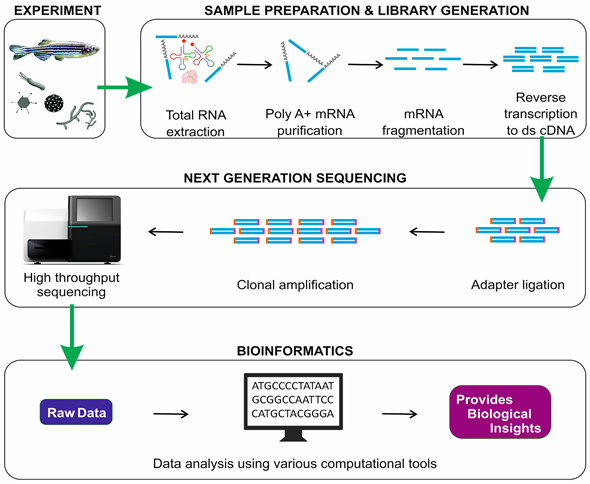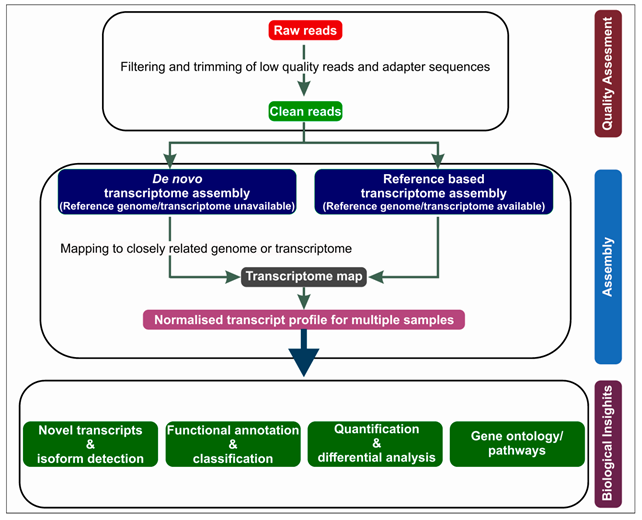Recent advancement in next generation sequencing strategies has lead us to great advancement of transcriptome studies. Various techniques for transcriptome analysis are available and widely used since development of microarray technology and sequencing of the human genome.
mRNA level measurements using microarray techniques or real-time PCR techniques became quickly popular, however, both these techniques had their limitations:
- Microarray approach had sensitivity issue and is vulnerable to errors such as contaminations which hampers downstream analysis progress and result accuracy.
- Real-time PCR techniques are extremely expensive and high risk of contamination.
High throughput next generation sequencing and robust transcriptome analysis help with gene expression profiling, gene annotation or discovery of non-coding RNA. Illumina short reads are popular for gene expression and transcriptome assembly studies while long reads from Pacbio and Oxford Nanopore have been used to study gene structure and isoform analysis.
RNA Seq or Transcriptome Analysis Comprises of Four Major Steps:
- Experimental design (Number of replicates)
- RNA seq library preparation to convert mRNA into cDNA library
- Sequencing cDNA library
- Bioinformatic RNA seq data analysis

Standard workflow of a RNA-seq based transcriptome analysis.
Int. J. Mol. Sci. 2018, 19(1), 245; https://doi.org/10.3390/ijms19010245
Transcriptome Analysis Workflow
RNA-Seq techniques generate hundreds of millions of short RNA reads using next-generation sequencing (NGS). These RNA reads can be mapped to reference genomes to investigate changes of gene expression but improved procedures for mining large RNA-Seq datasets to extract valuable biological knowledge are needed.
Analysis phase can be divided into 4 phases:
Phase 1: Raw Data QC
Phase 2: Alignment (or de Novo assembly if no reference genome available)
Phase 3: Post Alignment QC
Phase 4: Differential Expression determination
Phase 5: Annotation/ Pathway discovery

Transcriptome analysis (RNA Seq Pipeline) workflow for processing raw reads for various applications.
Int. J. Mol. Sci. 2018, 19(1), 245; https://doi.org/10.3390/ijms19010245
Transcriptome Analysis Applications:
- Transcriptomes of stem cells and cancer cells are of particular interest to researchers who seek to understand the processes of cellular differentiation and carcinogenesis.
- Transcriptome analysis of human oocytes and embryos is used to understand the molecular mechanisms and signaling pathways controlling early embryonic development, and could theoretically be a powerful tool in making proper embryo selection in in vitro fertilisation.
- Transcriptomics is an emerging and continually growing field in biomarker discovery for use in assessing the safety of drugs or chemical risk assessment.
- Transcriptome analysis may also be used to infer phylogenetic relationships among individuals.
- In recent years, single cell RNA seq techniques like 10x Genomics and BD Rhapsody have enabled transcriptome analysis in a single cell. A number of cancer studies are now focusing on mapping gene expression changes in tumor cells against normal tissue.
- Gene Ontology (GO) and Pathyway Analysis are tertiary transcriptome analysis techniques that provide a system biology angel for genes regulation across tissues or conditions.
- De Novo assembly of RNA seq reads can be performed to generate a reference transcriptome for species that have too large and complex genomes.


